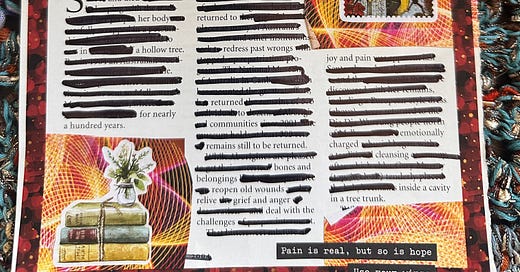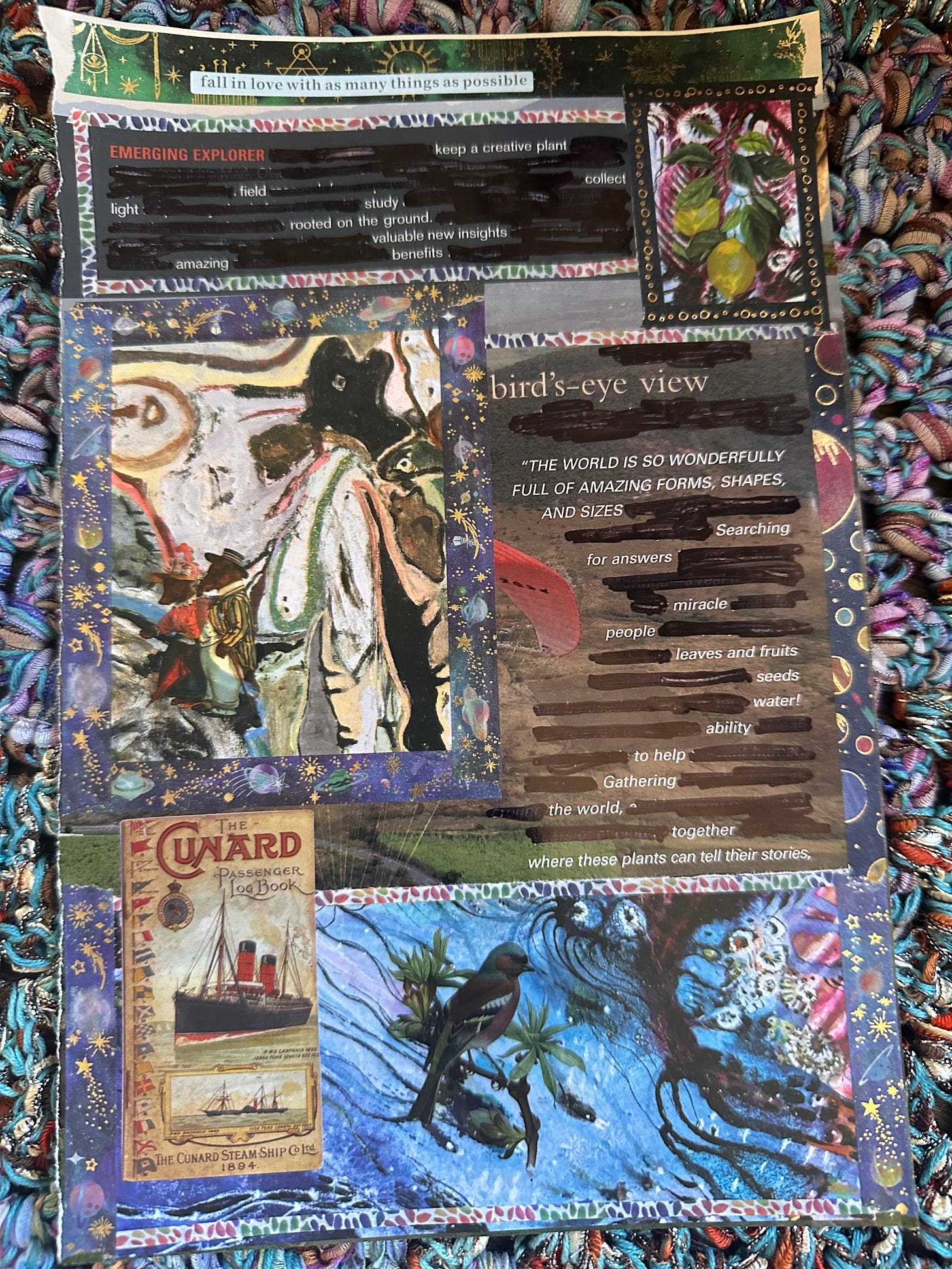Listen to me Read Blackout Poetry for the Substack Global Blackout Poetry Exchange
Celebrating community and creativity, what is Blackout poetry, and some sneak peeks from the contributors
I have been really enjoying the Substack Global Blackout Poetry Exchange that
and I decided to launch. The whole thing happened organically and quickly. Monique had posted about some “happy mail” that she received, and I commented that I’d love to do an exchange, and then we wondered if other people would like to join, and people did. There are over forty people from across the United States and many other countries (including Australia, Japan, Finland …) Each person was randomly assigned a single other person to send a piece of blackout poetry to.And I decided to make a big creative project out of it for myself, challenging myself to send a piece of mail to every contributor. I took a National Geographic magazine and went page by page, turning it into blackout poetry. Everyone’s approach is different, but for me, I also incorporate magazine images, stickers and decorative tape to create a collage-style page with the found poetry on it. I made about fifty of these out of that magazine and I’m getting ready to send them off to each individual contributor.
But before I do, I thought I’d record myself reading the poems. I admit my video skills weren’t great but you can hear my reading clearly by hitting play on the small videos. You can, however, see a video of all of the still images in a much better style at the end of this post. They are in no particular order and some pages are definitely more powerful than others, but here they are (the second video is my favorite one):
Below the videos you’ll find more about the project and about blackout poetry.
What is Blackout Poetry?
Blackout poetry is one variation on found poetry. The idea is that you take a piece of printed reading material and black out a bunch of the words leaving a “found poem” on the page.
Other types of found poetry:
Highlight Poetry: Created by highlighting specific words or phrases from a source text to form a poem, instead of blacking out the rest.
Erasure Poetry: Involves erasing or removing words from a source text to reveal a new poetic work.
Cut-Up Poetry: Constructed by cutting up words or phrases from one or more texts and rearranging them into a new composition.
Collage Poetry: Assembled by piecing together fragments of text from various sources to form a cohesive poem.
Cento Poetry: A patchwork of lines or phrases from other poems, rearranged into a new work.
Visual Poetry: A blend of text and imagery where the visual layout is integral to the poem’s meaning.
Remix Poetry: Combines and reinterprets text from different sources, altering or adapting them to create new meanings.
List Poetry: Involves compiling a list of found phrases or words that, when put together, evoke poetic meaning.
I suppose mine are a combination of blackout poetry and visualpoetry and a little bit of remix since I add in stickers with extra text.
Mental Health Benefits of Creating Blackout Poetry
Just a handful of the benefits of creating found poetry/ blackout poetry include:
Stress Reduction: The process can be meditative and calming, helping to reduce stress and anxiety levels.
Emotional Expression: Allows individuals to express emotions and thoughts indirectly through selected words, offering a safe outlet for difficult feelings.
Mindfulness Practice: Encourages focus and present-moment awareness, promoting mindfulness as creators engage deeply with the text.
Boosts Creativity: Stimulates creative thinking and problem-solving by transforming an existing text into something new and personal.
Sense of Accomplishment: Completing a poem offers a sense of achievement, which can enhance self-esteem and confidence.
Cathartic Release: The act of removing words and leaving others behind can serve as a symbolic release of negative emotions.
And in the case of this project, there’s also a sense of community that’s been built.
Substack Global Blackout Poetry Exchange
In case you want to know more about this project … Monique and I posted our invite to join to our Notes, people joined in, and we assigned partners to everyone.
“The Rules”
Here’s what I sent out to participants:
We are providing you with the address of the person you will send your blackout poetry to. You are the only person besides myself and Monique who is receiving this address. Please be respectful of the person’s privacy and do not share it with anyone else.
Mail your entry to this person postmarked by September 1st. If you are unable to send your mail postmarked by September 1st, please alert Monique and/or Kathryn; things happen in life, but it's disappointing for someone to sign up then not receive anything so don't hesitate to reach out and let us know that you need additional time/support/to have a different person assigned to your recipient.
All of the creative stuff is up to you. Send one poem or several. Add other stuff to the envelope or send it as a postcard. Decorate the mail however feels right. Spread creative connection! There’s no wrong way to do this! (Except, you know, use common sense and decency and be kind.)
Optional: Take a photo of your blackout poetry before you mail it off and email that photo to Kathryn.vercillo@gmail.com ... she will include all photos she receives in a PDF / post that everyone will have access to and can cross-post on Substack if they want to. This will come out in early fall, after all submissions have been received.
When you have received your mail from the person who sent it to you, please let us know by sending an email to Kathryn or posting an update on Substack and tagging Kathryn Vercillo and Monique Mulligan. Optional: Send a thank you, virtually or in the mail, to the person who sent your piece!
Sneak Peeks:
Check out the process photos in the comments here:
And here are some more sneak peeks:
Some Things To Look Forward To:
I’ll publish a roundup of the images that were sent to me from the project.
Check out everyone’s Notes and newsletters to see what they have shared.
Yes, there’s a good chance we’ll do something like this again in the future.
If you read this far, perhaps you liked the work. The work does take work. It only continues with support, so please consider subscribing. My annual rate starts at $10 per year.







Informative
This is so lovely! All of it!